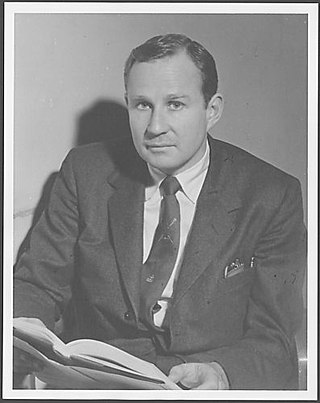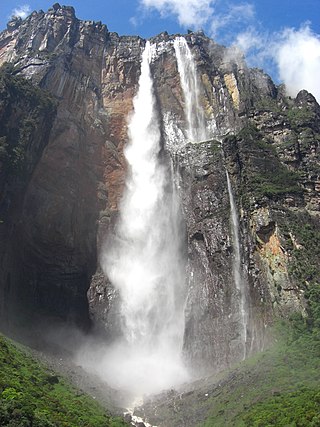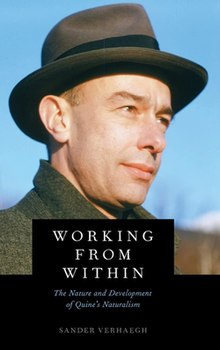Logical positivism, later called logical empiricism, and both of which together are also known as neopositivism, is a movement whose central thesis is the verification principle. This theory of knowledge asserts that only statements verifiable through direct observation or logical proof are meaningful in terms of conveying truth value, information or factual content. Starting in the late 1920s, groups of philosophers, scientists, and mathematicians formed the Berlin Circle and the Vienna Circle, which, in these two cities, would propound the ideas of logical positivism.
Metaphysics is the branch of philosophy that studies the fundamental nature of reality. This includes the first principles of: being or existence, identity, change, space and time, cause and effect, necessity, actuality, and possibility.

Willard Van Orman Quine was an American philosopher and logician in the analytic tradition, recognized as "one of the most influential philosophers of the twentieth century". He served as the Edgar Pierce Chair of Philosophy at Harvard University from 1956 to 1978.
An ontological commitment of a language is one or more objects postulated to exist by that language. The 'existence' referred to need not be 'real', but exist only in a universe of discourse. As an example, legal systems use vocabulary referring to 'legal persons' that are collective entities that have rights. One says the legal doctrine has an ontological commitment to non-singular individuals.

Rudolf Carnap was a German-language philosopher who was active in Europe before 1935 and in the United States thereafter. He was a major member of the Vienna Circle and an advocate of logical positivism. He is considered "one of the giants among twentieth-century philosophers."

Pragmatism is a philosophical tradition that views language and thought as tools for prediction, problem solving, and action, rather than describing, representing, or mirroring reality. Pragmatists contend that most philosophical topics—such as the nature of knowledge, language, concepts, meaning, belief, and science—are all best viewed in terms of their practical uses and successes.
Analytic philosophy is a branch of philosophy using analysis, popular in the Western world and particularly the Anglosphere, which began around the turn of the 20th century in the contemporary era in the United Kingdom, United States, Canada, Australia, New Zealand, and Scandinavia, and continues today. Analytic philosophy is often contrasted with continental philosophy, coined as a catch-all term for other methods, prominent in Europe.

The Vienna Circle of logical empiricism was a group of elite philosophers and scientists drawn from the natural and social sciences, logic and mathematics who met regularly from 1924 to 1936 at the University of Vienna, chaired by Moritz Schlick. The Vienna Circle had a profound influence on 20th-century philosophy, especially philosophy of science and analytic philosophy.

Wilfrid Stalker Sellars was an American philosopher and prominent developer of critical realism, who "revolutionized both the content and the method of philosophy in the United States".
"Two Dogmas of Empiricism" is a paper by analytic philosopher Willard Van Orman Quine published in 1951. According to University of Sydney professor of philosophy Peter Godfrey-Smith, this "paper [is] sometimes regarded as the most important in all of twentieth-century philosophy". The paper is an attack on two central aspects of the logical positivists' philosophy: the first being the analytic–synthetic distinction between analytic truths and synthetic truths, explained by Quine as truths grounded only in meanings and independent of facts, and truths grounded in facts; the other being reductionism, the theory that each meaningful statement gets its meaning from some logical construction of terms that refer exclusively to immediate experience.
Naturalized epistemology is a collection of philosophic views concerned with the theory of knowledge that emphasize the role of natural scientific methods. This shared emphasis on scientific methods of studying knowledge shifts focus to the empirical processes of knowledge acquisition and away from many traditional philosophical questions. There are noteworthy distinctions within naturalized epistemology. Replacement naturalism maintains that traditional epistemology should be abandoned and replaced with the methodologies of the natural sciences. The general thesis of cooperative naturalism is that traditional epistemology can benefit in its inquiry by using the knowledge we have gained from the cognitive sciences. Substantive naturalism focuses on an asserted equality of facts of knowledge and natural facts.
Neopragmatism, sometimes called post-Deweyan pragmatism, linguistic pragmatism, or analytic pragmatism, is the philosophical tradition that infers that the meaning of words is a result of how they are used, rather than the objects they represent.
Verificationism, also known as the verification principle or the verifiability criterion of meaning, is the philosophical doctrine which asserts that a statement is meaningful only if it is either empirically verifiable or a truth of logic.
The analytic–synthetic distinction is a semantic distinction used primarily in philosophy to distinguish between propositions that are of two types: analytic propositions and synthetic propositions. Analytic propositions are true or not true solely by virtue of their meaning, whereas synthetic propositions' truth, if any, derives from how their meaning relates to the world.
Meta-ontology is the study of the field of inquiry known as Ontology. The goal of meta-ontology is to clarify what ontology is about and how to interpret the meaning of ontological claims. Different meta-ontological theories disagree on what the goal of ontology is and whether a given issue or theory lies within the scope of ontology. There is no universal agreement whether meta-ontology is a separate field of inquiry besides ontology or whether it is just one branch of ontology.

Word and Object is a 1960 work by the philosopher Willard Van Orman Quine, in which the author expands upon the line of thought of his earlier writings in From a Logical Point of View (1953), and reformulates some of his earlier arguments, such as his attack in "Two Dogmas of Empiricism" on the analytic–synthetic distinction. The thought experiment of radical translation and the accompanying notion of indeterminacy of translation are original to Word and Object, which is Quine's most famous book.
Holophrastic indeterminacy, or indeterminacy of sentence translation, is one of two kinds of indeterminacy of translation to appear in the writings of philosopher W. V. O. Quine. According to Quine, "there is more than one correct method of translating sentences where the two translations differ not merely in the meanings attributed to the sub-sentential parts of speech but also in the net import of the whole sentence". It is holophrastic indeterminacy that underlies Quine's argument against synonymy, the basis of his objections to Rudolf Carnap's analytic/synthetic distinction. Another kind of indeterminacy introduced by Quine is the "inscrutability of reference", which refers to parts of a sentence or individual words.
The internal–external distinction is a distinction used in philosophy to divide an ontology into two parts: an internal part concerning observation related to philosophy, and an external part concerning question related to philosophy.

In philosophy, naturalism is the idea that only natural laws and forces operate in the universe. In its primary sense it is also known as ontological naturalism, metaphysical naturalism, pure naturalism, philosophical naturalism and antisupernaturalism. "Ontological" refers to ontology, the philosophical study of what exists. Philosophers often treat naturalism as equivalent to materialism.

The Quine–Putnam indispensability argument is an argument in the philosophy of mathematics for the existence of abstract mathematical objects such as numbers and sets, a position known as mathematical platonism. It was named after the philosophers Willard Quine and Hilary Putnam, and is one of the most important arguments in the philosophy of mathematics.








